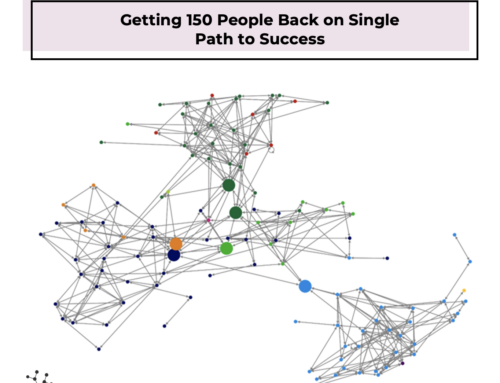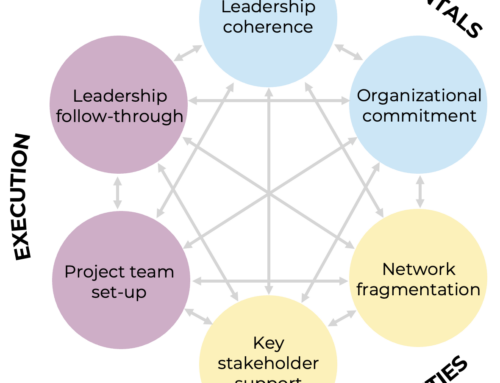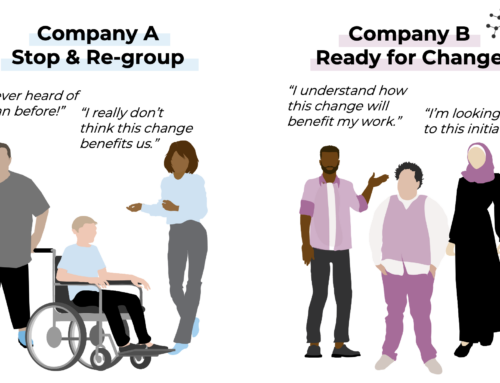CHRO’s Must-Win Battles Against Declining Connectivity and Growing Fragmentation
Every year, a forward-thinking and committed Chief Human Resources Officer (CHRO) uses the People Connectivity Accelerator to understand and act on the informal connectivity dynamics inside a 400+ company. This annual checkup isn’t just a checkup – it’s a dynamic assessment that empowers the CHRO to steer the company confidently through the unpredictability of the business world.
This is a sample output of the People Connectivity Accelerator and does not reflect this case
An Alarming Insight: 18% Drop in Connectivity in Just One Year!
The CHRO discovered something concerning in the most recent checkup: connectivity was under pressure. While this was an alarming insight, it wasn’t entirely unexpected. Internally, the company had gone through major workforce changes, and externally, the market focus was shifting.
The CHRO knew that strong connectivity was crucial for the company’s performance. Seeing the decline in connectivity and an 18% drop in the cohesiveness of the organizational network was disappointing. Over the past year, the company became more fragmented, posing immediate and future risks. The immediate risk was that this fragmented network hindered effective communication and knowledge sharing. The future risk would appear bleaker, with the possibility of organizational networks breaking into small cliques or silos if no action was taken.
The CHRO knew action was needed immediately.
What Was Causing the Fragmentation?
Two main factors were driving fragmentation.
- Smaller informal networks: The people were connecting with fewer people than before
- Inward-focused connections: The limited connections that did exist were mostly within their departments. Even the leadership team had become more insular, connecting mainly with each other.
Thankfully, by tracking connectivity every year, the company could see these issues early and take action to prevent further fragmentation.
The Two Actions to Combat Fragmentation and Rebuild Connections
The first action was to identify the people who could help combat fragmentation. This is where the Innovisor Connector Algorithm came into play, pinpointing the company’s connectors within each department. These individuals were uniquely well-connected within their teams. Remarkably, just seven connectors could help restore the network to its previous strength.
It was not enough to identify these connectors. The company needed to bring them together meaningfully, helping them build trust and collaborate.
The second action was to bring them together around a company-wide challenge. The identified challenge showed that the people didn’t feel they had the right tools to stay connected. As a result, the connectors were asked to work on this issue, looking into what worked well in some departments and what didn’t. Their goal was to provide advice on how to improve and get the company’s connectivity back on track, aiming to exceed the Innovisor benchmark.
The Three Must-Win Battles for Improved Connectivity
The work entrusted to the connectors didn’t end up forgotten. The CHRO remained focused and committed to implementing behavioral changes aimed at fostering connectivity across the organization.
Three must-win battles were defined and executed:
Must-Win Battle 1: Company-wide presentation
The connectors presented their findings and recommendations to the entire company. This group presentation highlighted that the initiative came from the employees themselves, not leadership.
Must-Win Battle 2: Sharing Best Practices Inside Departments
Each connector shared best practices with their respective departments. This peer-led approach ensured that the advice was practical and grounded in real experiences. Who better to rely on than these connectors? With their extensive connectivity within their departments, they brought invaluable insights to the table.
Must-Win Battle 3: Leadership Role Modeling
The CHRO had become familiar with the Innovisor Change Model through our collaboration. One of the pivotal drivers in increasing the willingness of people to change is role modeling. Hence, it was essential for leadership to exemplify collaborative behavior across the company. The CHRO made it possible to pair each leader with a “connector-buddy,” aimed at encouraging them to adopt and promote cross-collaborative practices.
Conclusion
The company managed to address the fragmentation in its workforce by tracking connectivity annually and taking proactive steps. Through identifying and empowering connectors and focusing on a shared challenge, they were able to rebuild their network and enhance the overall connectedness and performance.
Are you ready to build adaptive strategies in keeping your organization connected and resilient? Get your insights in only five days with our People Connectivity Accelerator.




















